Dryer No. 20
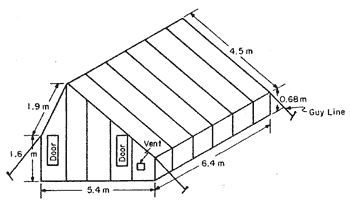
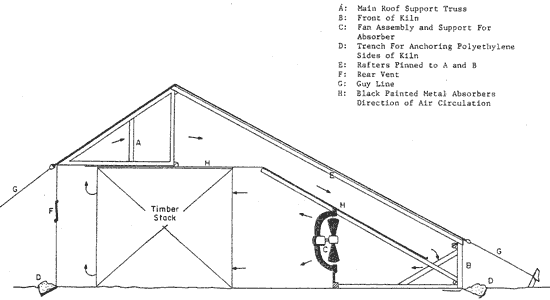
LOCATION: Oxford, ENGLAND
(Latitude 51 N; longitude 1 W)
STATUS: Experimental; operational since 1977
TYPE: Greenhouse
HEATING SYSTEM: Solar hot air collector; single layer of Mylar plastic glazing with black painted metal absorber
CIRCULATION: Two 24-inch (60 cm) diameter fans near the front wall push air through the load; ½ horsepower motors; controlled with a clock
VENTILATION: Exhaust vent in rear wall; intake vents in side walls near front
CAPACITY: 3000 board feet (7 cubic meters)
COLLECTOR AREA TO CAPACITY RATIO: 120 square feet per thousand board feet (4.7 square meters per cubic
meter)
Dryer No. 21
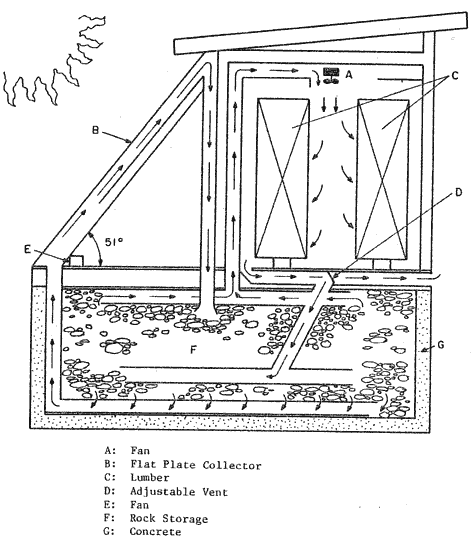
LOCATION: Ozone, Arkansas, USA
(Latitude 36 N)
STATUS: Experimental
TYPE: Opaque walls
HEATING SYSTEM: Solar hot air collectors; two layers of fiberglass polyester film; fiberboard painted black for the absorber, 2-inches below the glazing
CIRCULATION: Two 1/5 horsepower blowers (1000 cubic feet per minute – 0.47 cubic meters per second) near the roof blowing downward through the lumber and also through the storage pile and collector
VENTILATION: Vents in north wall for exhaust; intake unknown
CAPACITY: 1500 board feet (3.5 cubic meters)
CAPACITY TO COLLECTOR AREA RATIO: 110 square feet per thousand board feet (4.3 square meters per cubic meter)
LOADING: Four large doors on north wall to permit forklift access
OVERALL DIMENSIONS: Chamber – east-west, 20-ft (6.1 m); north-south, 6-ft (1.8 m); height, 8-ft (2.4 m)
Collector – Five 4 x 8-ft (1.2 x 2.4 m) collectors
CONSTRUCTION: frame construction with 2 x 4 framing; fiberglass insulated walls; sheathed inside with ½-inch (1.3 cm) plywood; sheathed outside with 1-inch (2.5 cm) lumber; roof is 2 x 6 framing with insulation and metal roof
STORAGE: A 6-inch (15 cm) thick concrete walled and insulated (1-inch – 2.5 cm) with Styrofoam chamber under the dryer and collector; size is 20 x 6 x 5-ft (6.1 x 1.8 x 1.5 m); chamber is filled with 2 to 4-inch (5 to 10 cm) diameter rocks; storage temperatures are very low; effectiveness questioned by designer
REFERENCES:
Article – Robbins, A. M. ca. 1983. Solar lumber kilns: design ideas. New Mexico Energy Research and Development Institute, University of New Mexico (Albuquerque). 17p.
Present Contact: Mr. John Alexander
Dryer No. 22
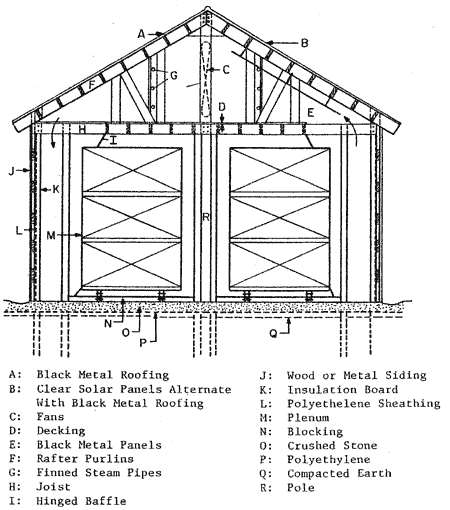
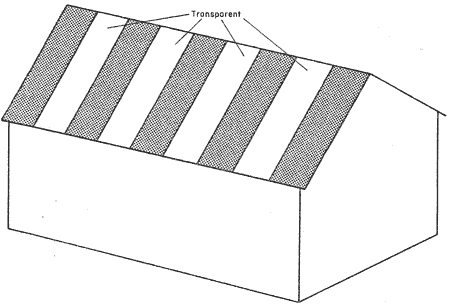
LOCATION: Princeton, West Virginia, USA
(Latitude 37 N; longitude 81 W)
STATUS: Operational
TYPE: Semi-greenhouse with translucent panels only on south-facing half of roof; entire dryer painted black on exterior
HEATING SYSTEM: Solar hot air collectors; steam heat supplemental when temperature inside drops below 80 F (27C)
CIRCULATION: four 6-ft (1.8 m) diameter fans, each pair driven by 7.5 horsepower motors; velocity through the load is approximately 500 feet per minutes (2.5 meters per second)
VENTILATION: Not specified
CAPACITY: 25,000 board feet (59 cubic meters)
CAPACITY TO COLLECTOR AREA RATIO: 13 square feet per thousand board feet (0.51 square meters per cubic meter)
LOADING: Two pairs of tracks from west end
OVERALL DIMENSIONS: East-west, 36-ft (11 m); north-south, 28-ft (8.5 m); height, ca. 24-ft (7.3 m)
CONSTRUCTION: Load bearing 6 x 6 post with 2.6 furring; wood siding painted black; 2 x 10 joists and rafters; metal roofing on north slope painted black and clear fiberglass panels alternate with metal roofing on south slope; all roofing on 2 x 4 purlins
STORAGE: None.
PERFORMANCE: Drying times –
| Species | Thickness | Final MC | Time |
| Inches (cm) | % | Days | |
|
Red Oak | 4/4 (2.5) | 20 | 19-23 |
| 5/4 (3.2) | 25 | 30-35 | |
| 8/4 (5.0) | 25 | 57-62 | |
|
White oak | 4/4 (2.5) | 20 | 17-20 |
| 5/4 (3.2) | 25 | 28-32 | |
| 8/4 (5.0) | 25 | 55-60 | |
|
Beech | 4/4 (2.5) | 20 | 8-10 |
| 5/4 (3.2) | 20 | 10-12 | |
|
Soft maple | 4/4 (2.5) | 20 | 6-7 |
| 5/4 (3.2) | 20 | 7-8 | |
| 5/4 (3.2) | 12 | 11 | |
|
Hard maple | 4/4 (2.5) | 20 | 8-10 |
| 5/4 (3.2) | 20 | 12-14 | |
|
Hickory | 4/4 (2.5) | 20 | 16-18 |
| 5/4 (3.2) | 20 | 22-24 |
REFERENCES:
Dryer No. 23
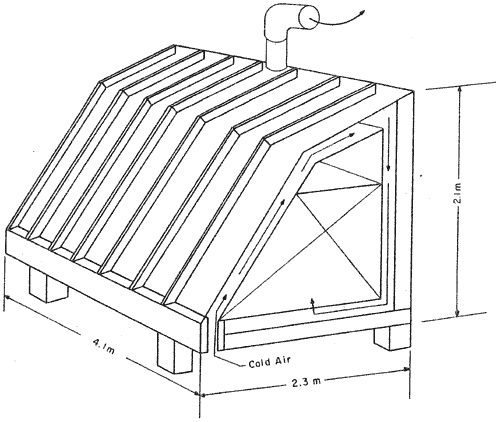
LOCATION: Reader, West Virginia, USA
(Latitude 40 N; longitude 80 W)
STATUS: Operational
TYPE: Semi-greenhouse with roof and south wall transparent
HEATING SYSTEM: Solar hot air collectors; glazing is a single layer of fiberglass flat panels; absorber is black painted aluminum
CIRCULATION: Natural draft with chimney flue extending down to top of lumber pile
VENTILATION: Natural draft open and closed by heat activated vent motor
CAPACITY: 1000 board feet (2.3 cubic meters)
CAPACITY TO COLLECTOR AREA RATIO: 120 square feet per thousand board feet (4.7 square meters per cubic meter)
LOADING: Manual loading through doors in east and west walls
OVERALL DIMENSIONS: East-west, 13.5-ft (4.1 m); north-south, 7.5-ft (2.3 m); height, 7-ft (2.1 m)
CONSTRUCTION: Frame construction with 2 x 4 framing; insulated walls and floor
STORAGE: None
PERFORMANCE: Drying time for cherry 4/4-inches (2.5 cm) thick from 39% MC to 15% MC is 2 weeks and to 8% MC is 6 weeks
REFERENCES:
Present Contact: Dennis Scanlin
124 Lincoln Avenue
Morgantown, West Virginia 26505
USA
Dryer No. 24
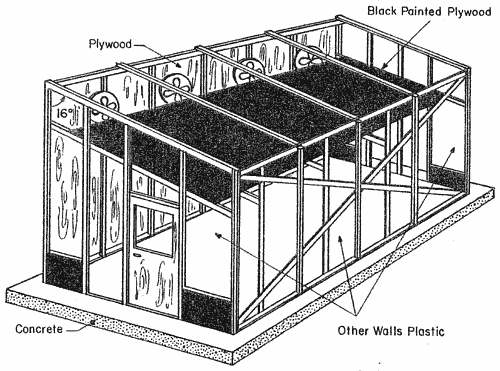
LOCATION: Rio Piedras, PUERTO RICO
(Latitude 17 S; longitude 67 W)
STATUS: Experimental
TYPE: Greenhouse
HEATING SYSTEM: Solar hot air collectors; 2 layers of glazing; a corrugated, black metal absorber was located 12-inches (30 cm) below the roof glazing
CIRCULATION: Four 16-inch (40 cm) diameter fans near the roof peak blowing down the absorber plate; driven by one 1-1/2 horsepower motor
VENTILATION: Two openings on both the east and west walls near the floor; adjustable louvers
CAPACITY: 3000 board feet (7.1 cubic meters)
COLLECTOR AREA TO CAPACITY RATIO: 74 square feet per thousand board feet (2.9 square meters per cubic meter)
LOADING: Door in north wall
OVERALL DIMENSIONS: East-west, 20-ft (0.1 m); north-south, 10-ft (3.0 m); height of north wall, 13.3-ft (4.1 m)
CONSTRUCTION: Frame construction with 2 x 4 framing; glazing materials included two layers polyvinyl fluoride film, but now is a single layer of double strength glass; concrete floor; solid north wall; a small hot water solar collector was used to heat water which was then sprayed as a mist into the dryer to control humidity and relieve casehardening at the end of drying
STORAGE: None
PERFORMANCE: Drying time for 1-inch (2/5 cm) thick mahogany from 35% MC to 8-12% MC is 25 days
Drying time for 1.25-inch (3.2 cm) thick mahogany from 50% MC to 11% MC is 30 days
Drying time for 2-inch (5 cm) thick mahogany from 60% MC to 14% MC is 39 days
Drying time for mixed hardwoods 1.25-inch (3.2 cm) thick from 38-80% MC to 11% MC is 44 days
Quality was much better than air-drying. Plastic coverings became brittle within two years and were replaced with glass.
REFERENCES:
Article – Chudnoff, M., E. D. Maldonado, and E. Goytia. 1966 Solar drying of tropical hardwoods. USDA Forest Service Institute of Tropical Forestry Research Paper ITF-2. (Puerto Rico) 26p.
Maldonado, E. D. and E. C. Peck. 1962. Drying by solar radiation in Puerto Rico. Forest Products J 12(10):487-488.
Present Contact: R. S. Boone
Forest Products Laboratory
PO Box 5130
Madison, Wisconsin 53705
USA
Dryer No. 25
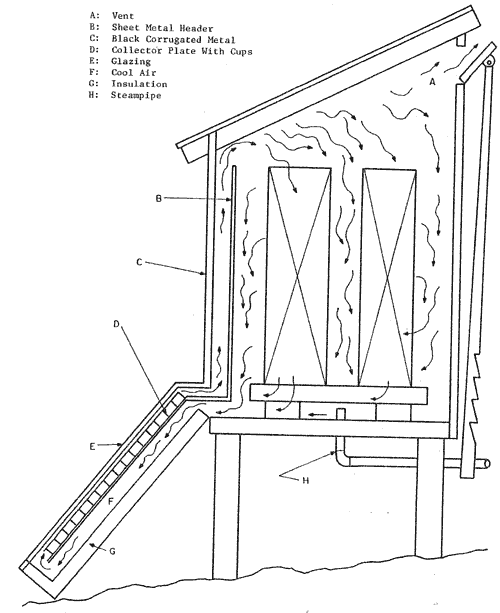
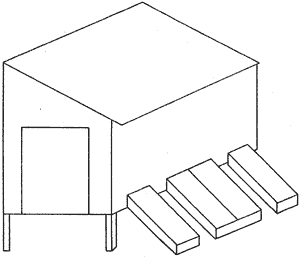
LOCATION: San Juan, New Mexico, USA
(Latitude 36 N)
STATUS: Experimental
TYPE: Opaque walls
CIRCULATION: Natural
VENTILATION: Four small vents in north wall near roof for exhaust and intake vents in collectors
CAPACITY: 1000 board feet (2.4 cubic meters)
CAPACITY TO COLLECTOR AREA RATIO: 71 square feet per thousand board feet (2.8 square meters per cubic meter), not including black painted roof
LOADING: Manually through doors in east and west walls
OVERALL DIMENSIONS: Inside – East-west, 16-ft (4.9 m); north-south, 8-ft (2.4 m); height, ca. 13-ft (4 m)
CONSTRUCTION: Frame construction with 2 x 4 framing and insulation for east, west and north walls; south wall and roof covered with corrugated metal painted black. Four solar collector boxes, each 3 x 6-ft (0.9 x 1.8 m); steam spray line for relief of casehardening at the end of drying
STORAGE: None
PERFORMANCE: Drying time for ponderosa pine, 2-inches (5 cm) thick, from 30% MC to 5% MC is 60 to 70 days
REFERENCES:
Article – Robbins, A. M. ca. 1983. Solar lumber kilns. New Mexico Energy Research and Development Institute, University of New Mexico (Albuquerque). 17p.
Present Contact: Mr. John Vincent
PO Box 32
San Juan Pueblo, New Mexico 87566
USA
Dryer No. 26
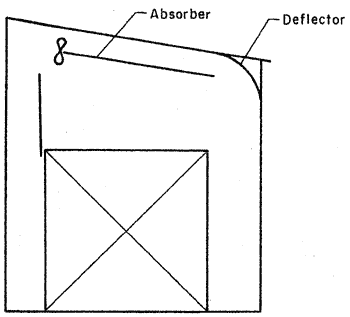
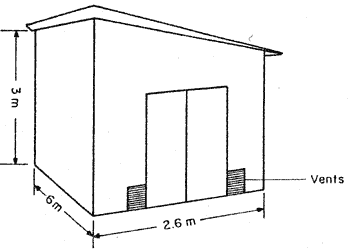
LOCATION: Santarem, Para, BRAZIL
(Latitude 3 S; longitude 55 W)
STATUS: Experimental
TYPE: Greenhouse; four walls and roof transparent; nearly identical to Puerto Rico kiln (#24)
HEATING SYSTEM: Solar hot air collectors; single layer of plastic; all surfaces in dryer painted black
CIRCULATION: Three fans; 0.3 horsepower each
VENTILATION: Two vents on east wall and two on west wall
CAPACITY: 4200 board feet (10 cubic meters)
CAPACITY TO COLLECTOR AREA RATIO: 38 square feet per thousand board feet (1.5 square meters per cubic meter)
LOADING: Manually
OVERALL DIMENSIONS: East-west, 19.7-ft (6.0 m); north-south, 8.4-ft (2.55 m); height, ca. 10-ft (3 m)
CONSTRUCTION: Frame construction with 2 x 4 framing; concrete floor
STORAGE: None
PERFORMANCE: Drying time for tachi from 80% MC to 17% MC is 103 days; for fara tamboril from 90% MC to 11% MC is 103 days; for cupiuba from 47% MC to 10% MC is 103 days; and andiroba from 28% MC to 9% MC is 73 days
REFERENCES:
Article – SUDAM/IPT. 1981. Estudo sobre metodos de secagem de madeiras da Amazonia. SUDAM (Belem). 77p.
Present Contact: Cesar A. C. Lopes
CTM da Sudan
Santarem, Para
BRAZIL
Dryer No. 27
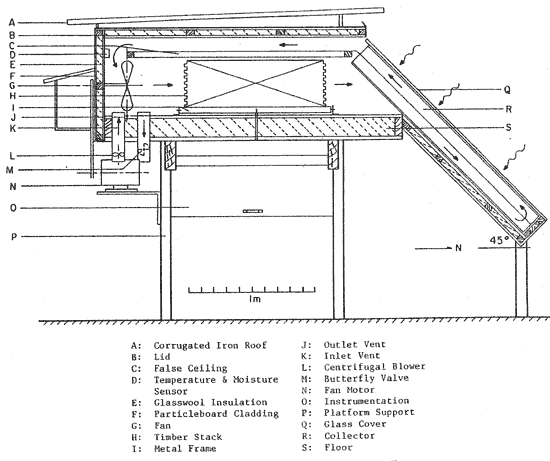
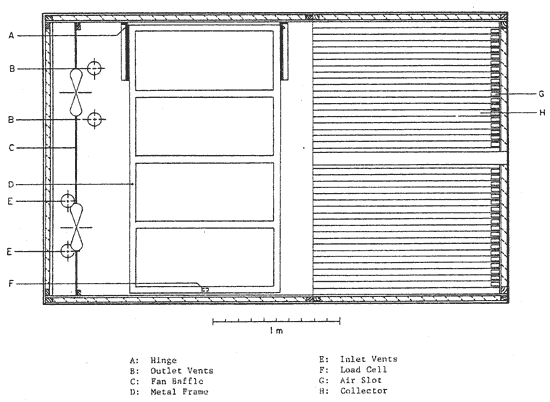
LOCATION: Stellenbosch, SOUTH AFRICA
(Latitude 35 S; longitude )
STATUS: Experimental
TYPE: Opaque walls
HEATING SYSTEM: Solar hot air collector; finned aluminum absorber; single layer of glass for glazing
CIRCULATION: Two 15-inch (38 cm) fans driven by a single 1 horsepower motor; fans provided flow through the collector and lumber pile
VENTILATION: Two 4-inch (10 cm) diameter pipes each with a centrifugal blower were placed on the suction side of one fan; two more pipes were placed on the pressure side of the other fan, but were without fans; venting controlled by computer
CAPACITY: 180 board feet (0.43 cubic meters)
CAPACITY TO COLLECTOR AREA RATIO: 250 square feet per thousand board feet (9.8 square meters per cubic meter)
LOADING: Roof and top removed for manual loading
OVERALL DIMENSIONS: Chamber – east-west, 7.6-ft (2.3 m); north-south, 7.1-ft (2.2 m); height, 2.9-ft (0.9 m); constructed 4.6-ft (1.4 m) above the ground
Collector – east-west, 6.3-ft (1.91 m); north-south sloped distance, 7.1-ft (2.15 m)
CONSTRUCTION: Frame construction with 1-1/2-inches (4.cm) of glass-wool insulation; walls covered with exterior particleboard; roof is similar to walls; above chamber roof is corrugated metal roof
STORAGE: None
PERFORMANCE: Drying time for radiata pine, 4/4-inches (2.5 cm) thick, from 93% MC to 12% MC is 16 days
End checking reduced from 21% in air drying to 6% in solar Mild casehardening in solar with fans running continuously
REFERENCES:
Article – Steinmann, D. E., H. F. Vermaas, and J. Bl Forrer. 1980. Solar timber drying kilns: Part I: Review of previous system and control measures and description of an automated solar kiln. J of Institute and Wood Science 48:254-257.
Steinmann, D. E., H. F. Vermaas, and J. B. Forrer. 1980. Solar timber drying kilns: Part II: Microprocessor control of a solar kiln. J of Institute of Wood Science 49:27-31.
Present Contact: Dr. Dieter E. Steinmann
Department of Wood Science
University of Stellenbosch
Stellenbosch 7600
SOUTH AFRICA
Dryer No. 28
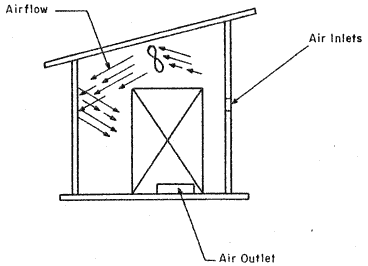
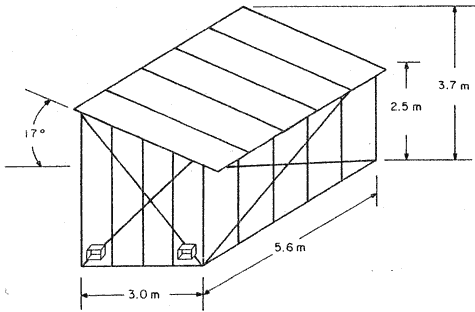
LOCATION: Tananarive, MADAGASCAR
(latitude 19 S: longitude 47E)
STATUS: Operational
TYPE: Greenhouse
HEATING SYSTEM: Solar hot air collectors; corrugated fiberglass polyester glazing; surfaces in the dryer are painted black
CIRCULATION: Two 20-inch (60 cm) diameter, located near the roof and at an angle of 45 degrees toward the floor
VENTILATION: Vent exhaust opening on east and west wall and two intake openings (approximately 8-inches x 16-inches) on north wall
CAPACITY: 1900 board feet (4.4 cubic meters)
COLLECTOR AREA TO CAPACITY RATIO: 91 square feet per thousand board feet (3.6 square meters per cubic meter)
LOADING: Door in west wall
OVERALL DIMENSIONS: East-west, 18-ft (5.6 m); north-south, 10-ft (3 m); height, 12-ft (3.7 m)
CONSTRUCTION: Frame construction; concrete floor
STORAGE: None
PERFORMANCE: Drying time for pine boards, 1 x 8-inches (2.7 x 20 cm) from green to 20% MC is 55-75 days and to 8% MC is 138 days
Drying time for pine planks 3 x 9-inches (8 x 23 cm) from green to 20% MC is 94 days and to 16% MC is 138 days
Drying time for rosewood beams, 5 x 5-inches (12 x 12 cm) from green to 20% MC is 107 days and to 13% is 138 days
Drying time for rosewood rafters, 2 x 5-inches (5 x 12 cm) from green to 20% MC is 70 days and to 8% MC is 138 days
REFERENCES:
Article – Gueneau, P. 1970. An experiment on solar drying of wood. Bois Forest Tropical (131);69-78
Dryer No. 29
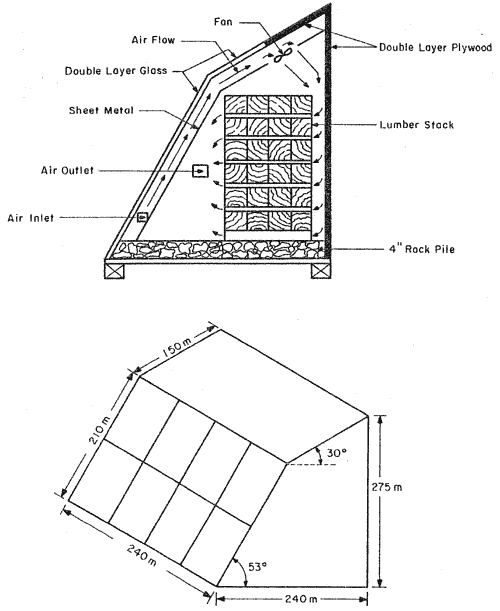
LOCATION: Thunder Bay, Ontario, CANADA
(Latitude 48 N; longitude 89 W)
STATUS: Experimental; operational since 1978
TYPE: semi-greenhouse with transparent roof and south wall
HEATING SYSTEM: Solar hot air collectors; double layer of glass with a black-painted metal absorber approximately 12-inches below the glass
CIRCULATION: Large fan blowing downward
VENTILATION: Exhaust and intake vents on both east and west walls; small fans assist in ventilation
CAPACITY: 500 board feet (1.18 cubic meters)
COLLECTOR AREA TO CAPACITY RATIO: 94 square feet per thousand board feet (3.7 square meters per cubic meter)
LOADING: Fork lift loading through doors in the north wall
OVERALL DIMENSIONS: East-west, 8-ft (0.24 m); north-south, 8-ft (0.24 m); north wall height, 9-ft (0.275 m)
CONSTRUCTION: Frame construction with 2 x 4 framing; east, west and north walls and upper half of the roof made with 5/8-inch plywood inside and outside the 2 x 4 framing (3-1/2 inch air space); later another 2 x 4 was added inside along with 3-1/2 inches of fiberglass insulation (R-20) and a ½-inch sheet of plywood
STORAGE: Gravel bed 4-inches (10 cm) deep on floor of kiln
PERFORMANCE: Drying time for jack pine studs ( 2 x 4’s) from 60% MC to 19% MC is 100 days in winter and 12 days in summer Dries lumber 2.3 times faster than air drying in winter and 9 times faster in summer Drying quality is much better than air drying (5-9 times less defects); less warping in solar drying
REFERENCES:
Article – Yand, K. C. 1980. Solar kiln performance at a high latitude, 48 N. Forest Products J 30(3):37-40.
Present Contact: Dr. K. C. Yang
Lakehead University
Thunder Bay, Ontario
CANADA P7B5E1
Dryer No. 30
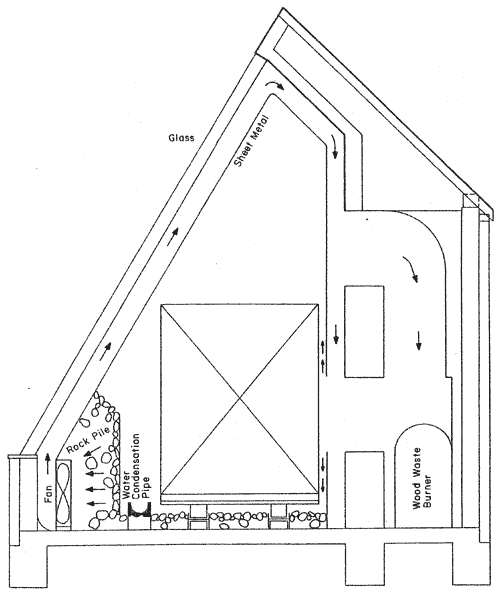
LOCATION: Thunder Bay, Ontario, CANADA
(Latitude 48 N; longitude 89 W)
STATUS: Experimental prototype
TYPE: Semi-greenhouse with backup wood waste burners
HEATING SYSTEM: Solar hot air collectors; triple layer of glass on south sloped roof with black painted sheet metal absorber; wood waste hot air burner
CIRCULATION: Fan or fans near floor blowing up collector
CAPACITY: 100,000 board feet (235 cubic meters)
COLLECTOR AREA TO CAPACITY RATIO: 20 square feet per thousand board feet (0.79 square meters per cubic meter)
LOADING: Lumber is on carts which are placed on tracks which enter from the side
OVERALL DIMENSIONS: East-west, 66-ft (20 m); north-south, 50-ft (15 m); overall height, 20-ft (6 m)
CONSTRUCTION: Wood frame with fiberglass insulation
STORAGE: Rock gravel bed
REFERENCES:
Present Contact: Dr. K. C. Yang
Lakehead University
Thunder Bay, Ontario
CANADA, P7B 5E1
Dryer No. 31
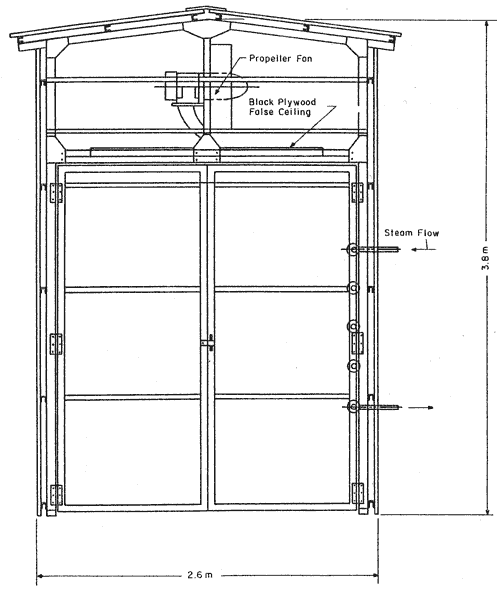
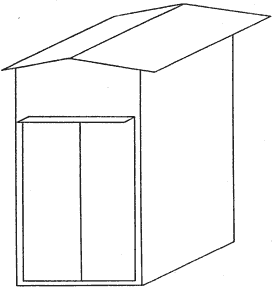
LOCATION: Tokyo, JAPAN
(Latitude 36 N; longitude 140 E)
STATUS: Experimental in 1962
TYPE: Greenhouse
HEATING SYSTEM: Solar hot air collectors; outer layer of corrugated polyvinyl chloride (translucent fiberglass) panels and inner layer of flat PVC panels; black painted plywood absorber; steam heat available to supplement at night
CIRCULATION: One 24-inch (61 cm) fan; fan located near roof; 1 horsepower motor
VENTILATION: An opening in the north wall with a fan was used for ventilation
CAPACITY: ca. 3300 board feet (ca. 7.8 cubic meters)
COLLECTOR AREA TO CAPACITY RATIO: ca. 29 square feet per thousand board feet (ca. 1.1 square meters per cubic meter)
LOADING: Track loaded from front
OVERALL DIMENSIONS: East-west, 8.5-ft (2.6 m); north-south, 11-ft (3.4 m); height, 12.5-ft (3.8 m)
CONSTRUCTION: Frame construction with angle iron framing
STORAGE: None
PERFORMANCE: Drying time for 1.4-inch (3.7 cm) thick red luan from 90% MC to 20% MC is 15 days in August and 20 days in November
REFERENCES:
Present Contact: Government Forest Experiment Station
Shimomeguro 5-37-21
Meguro-ku, Tokyo
JAPAN
Appendix
Sample Board Method of Measuring Moisture Contents and Drying Rates
In order to measure the moisture content of lumber during drying, it is impractical to weight every board in the dryer and electric meters are not accurate enough. Therefore, we used the sample board method to estimate the moisture of the lumber in the kiln. This method uses short, carefully chosen sample boards sawn from larger pieces of lumber. These sample boards are weighted periodically and their moisture contents are calculated. Generally, because the wettest lumber in the kiln has the highest risk of degrade development, the sample boards should represent the wettest lumber in the dryer; this means the lumber that is the most recently cut, is the widest and thickest, contains the heartwood, and is quartersawn.
The precise procedures to prepare sample boards are:

Wet weight, step 4
% MC = (------------------------------------------- -1) x 100
oven-dry weight, step 9
(wet weight, step 5)
Est. OD weight = ------------------------------------------------ x 100
100 + (%MC, step 10)
Current weight, step 13
Current %MC = (---------------------------------------------- -1) x 100
Est. OD weight, step 11